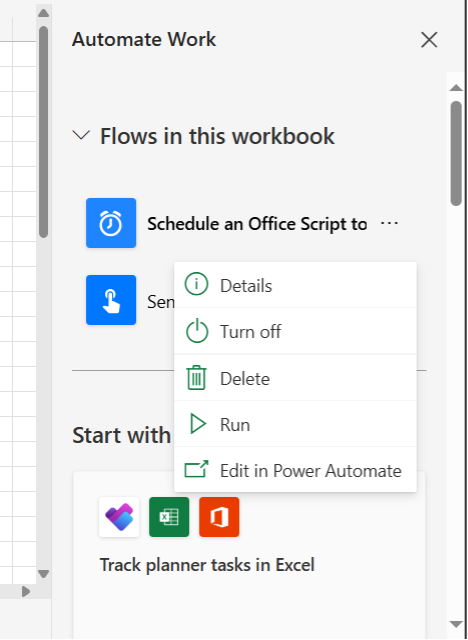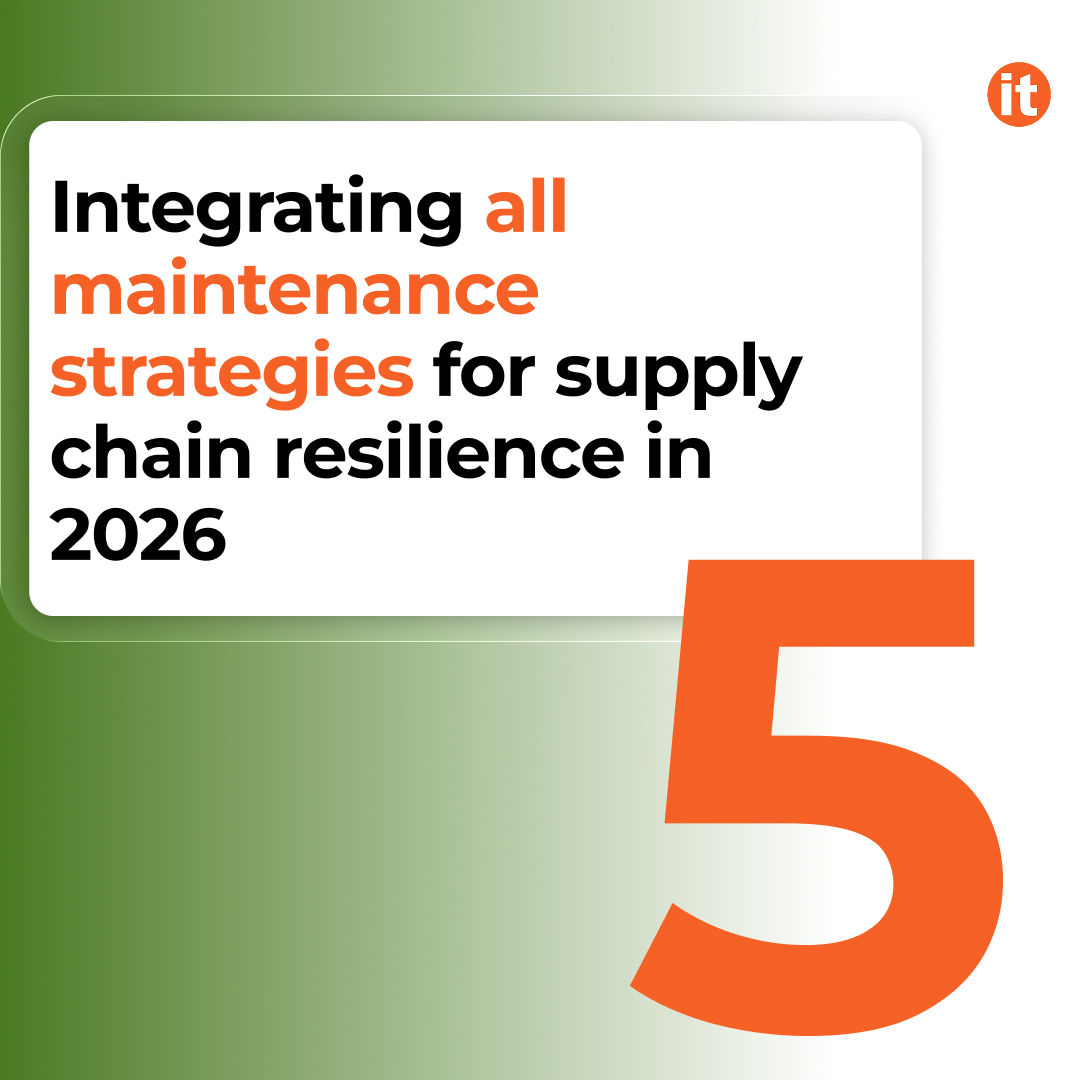Discover insights on the latest Microsoft Power Platform release wave from our Power Platform Consultants, including Copilot enhancements, Power Apps innovations, and Dataverse updates. Learn how these new features can boost your productivity and drive adoption in real-world projects.
Introduction
As part of our ongoing work with Microsoft Power Platform, we recently reviewed the capabilities released over the last few release waves to identify new features that could enhance productivity or drive better user adoption in our current projects.
Microsoft continues to lead the way in low-code innovation, delivering significant updates to Power Platform twice a year. These updates, outlined in the official Power Platform Release Planner, are essential reading for anyone actively working with the platform – especially given the pace at which new capabilities are being introduced.
Recent waves have focused heavily on expanding Copilot capabilities across the platform, while continuing to strengthen core tools including Power Apps, Power Automate, and Dataverse.
In this article, we share our personal highlights and honest thoughts on the updates that stood out and how they could bring real value in practice.
New AI Features:
Use Copilot to build apps in Power Apps:
Overview
Using Copilot, you can create apps without writing code or designing screens. You can just use natural language to explain to the system what you need and what your app must do. Describe which information you are going to capture and use in your app, and Copilot will generate Dataverse tables and app configuration for you. This new feature is designed to significantly simplify the process of building applications.

Our thoughts:
In practice, the usefulness of the AI assistant is quite mixed. To get exactly what you need, you have to provide a very detailed description to ensure the AI understands you correctly. If you need a complex solution, this process can be time-consuming. An experienced developer might spend less time manually creating the necessary tables than composing a precise description of them for Copilot.
Copilot doesn’t always understand your commands and may not always be able to do what you need. During testing, we asked it to create a lookup field in a table referencing the “User” system table, but it failed to do so and instead created a simple text field.
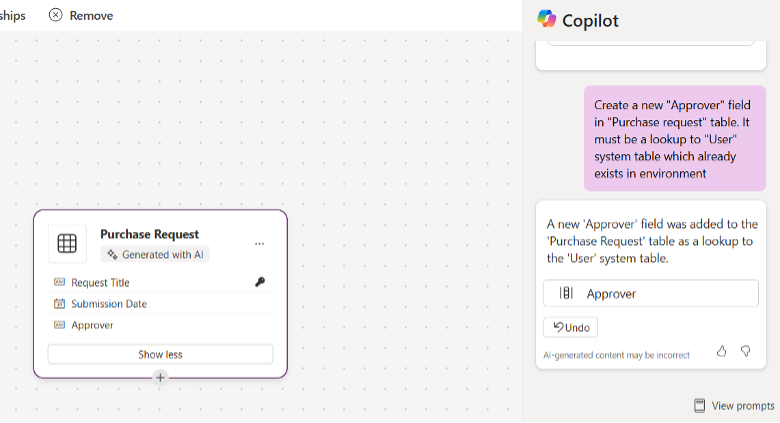
Moreover, when working with Copilot to build an app, you have limited options for manual editing. For example, when creating relationships between tables, you can’t configure the Relationship Behavior settings. This means that after finishing your work with the AI, you’ll still need to spend time fine-tuning the system manually using the standard configuration tools.
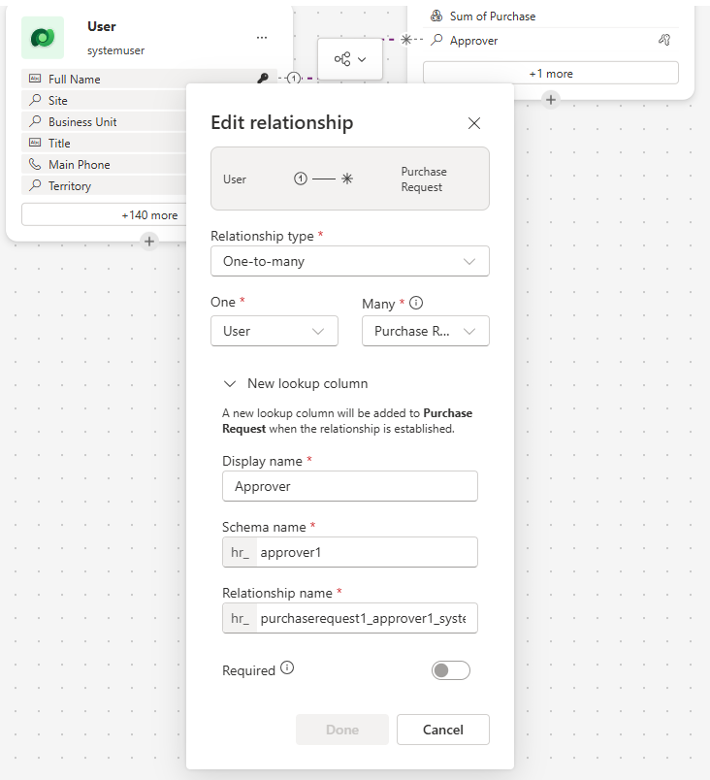
To summarize, this feature can be useful when building simple solutions and is especially helpful for users who lack experience with Dataverse or app development. Copilot in Power Apps is a revolutionary technology, and now it demonstrates remarkable progress. However, in order to unlock its real potential for professionals working on large and complex projects, it still requires further development and refinement.
Use Copilot to create flows in Power Automate when creating flows:
Overview:
By using natural language, you can tell the assistant what kind of flow you need, and it will create it for you. You can also ask Copilot questions related to development or use it to modify existing flows. This feature allows anyone to build automations – even those without technical knowledge.

Our thoughts:
However, during testing, we discovered that the AI assistant’s capabilities are narrower than anticipated. According to your description, Copilot creates a flow template by inserting a trigger and actions, but leaves parameters blank – you should enter them manually or compose additional prompts.

So, you spend a lot of time writing a prompt that Copilot can correctly interpret, and in the end, you only get a flow template – something an experienced developer could build manually in less time.
Just like with Power Apps, it’s currently difficult to find a truly practical use case for Copilot in Power Automate. A person without technical knowledge will likely struggle to complete the flow by entering all the necessary parameters in complex scenarios, while a professional developer will find it easier to build the flow manually than to write a complex explanation for the AI assistant.
Use Copilot to build websites in Power Pages:
Overview:
To create a website, you need to describe your needs in natural language, including the type of site, a description of the users who will be using it, and the kind of information the site will handle. Based on your description, the AI assistant will generate a site and its pages, which you can continue to edit using Copilot.
Our thoughts
We tested Copilot in Power Pages, and it allowed us to quickly create a website with two web pages and a form linked to a Dataverse table. However, to build a truly high-quality, functional, and visually appealing site, you need to make many adjustments to what the AI provides, which can become exhausting over time. Additionally, Copilot’s functionality still needs to be expanded, as we faced some limitations during the testing – for example, the AI assistant currently cannot delete forms.
It’s hard to deny that Copilot offers a completely new experience in Power Platform development. However, at this stage, it’s still difficult to find practical use cases for it in real, complex business scenarios. In most cases, a developer will prefer to configure things manually rather than spend time writing detailed prompts and then adjusting the output generated by Copilot. Another challenge is the limited range of actions Copilot can perform, which means that during development, you’ll frequently need to fall back on the traditional development approach.
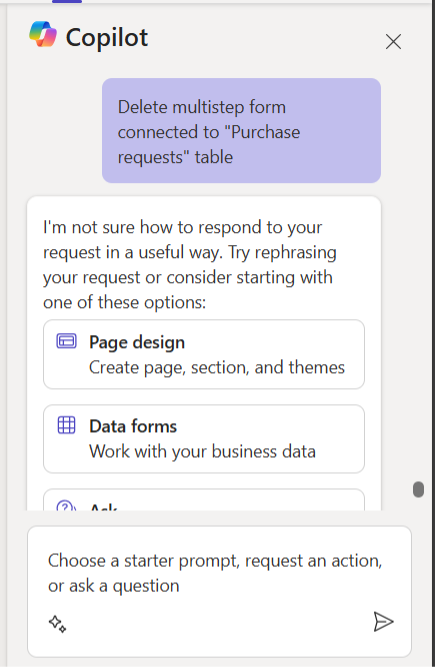
Copilot for users in model-driven apps:
Overview:
Users can use Copilot chat in model-driven applications to ask questions about the data they have access to, as well as to navigate to the necessary pages using natural language in a conversation with the AI assistant.
Our thoughts:
This functionality can simplify and speed up user navigation, especially in apps with many areas and pages. It also facilitates the extraction of insights from data and serves as a valuable alternative to traditional filtering and sorting features.
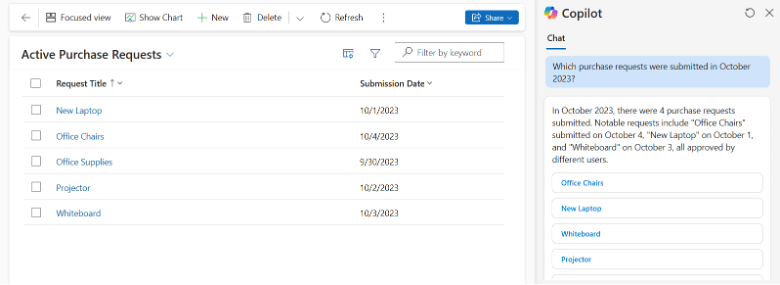
Copilot for users in Power Pages sites:
Overview:
Copilot in Power Pages allows users to ask questions in natural language and receive AI-generated responses based on the data hosted on the site and its content. It’s also possible to use Dataverse tables utilized on the site as data sources for the AI assistant’s answers.
Our thoughts:
This functionality is valuable because it significantly enhances the visitor experience. Instead of scrolling through the site to find answers, users can now simply type a question to get the information they need.
Use Copilot to generate a record summary in model-driven apps (preview):
Overview:
Developers can now create prompts to generate summaries of any record in model-driven apps. While writing a prompt, the developer can choose which specific data to use for generating the summary. This data can include values from the fields of the record itself as well as values from related table records.
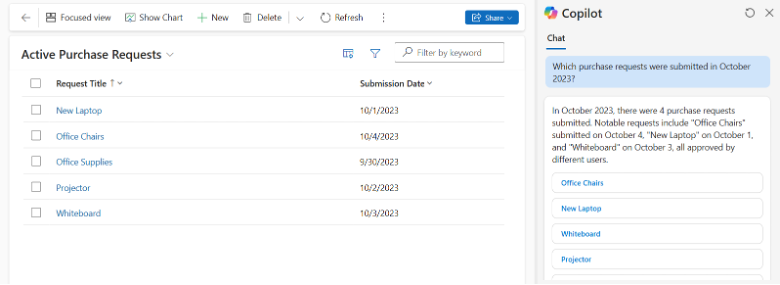
Our thoughts:
This functionality is especially useful in cases where forms contain a large number of fields and sub-grids spread across multiple tabs. Users will be able to quickly access key information about a record without having to search through the form by scrolling and switching between tabs. Additionally, it is convenient that users can read record summaries directly from the table view. It significantly reduces the time needed to consume information since they won’t have to drill through each record.

Currently, this functionality is not fully reliable, as it is still in “Preview”. More definitive conclusions can be drawn once it becomes generally available. In our opinion, it would also be beneficial to enhance Copilot so that it can generate summaries not only based on table data but also by using other system-accessible data sources, as well as perform calculations. This would significantly expand its summarization capabilities. For example, during testing, we found that the AI assistant was unable to determine the current date in order to calculate the number of remaining days.
Use AI’s form fill assistance feature in model-driven apps:
Overview:
AI can now predict what data a user is likely to enter in a new record, based on the existing data in the record and the values the user most frequently inputs. These suggestions are optional, so the user can either accept or reject them. Additionally, there are features currently in Preview that allow users to populate forms using uploaded files or copied values.
Our thoughts:
To test the new feature, we created a Word document where we entered field names and the corresponding values we wanted to populate in a new record within the app. We tested three input methods: copying and pasting the text directly into the app, uploading the document to the form, and uploading a screenshot of the text. In all three cases, we received positive results. The only big problem is that AI currently supports a limited range of data types. As a result, we were unable to automatically populate multi-line text fields and fields containing monetary values. Most probably, the list of supported data types will be expanded over time.

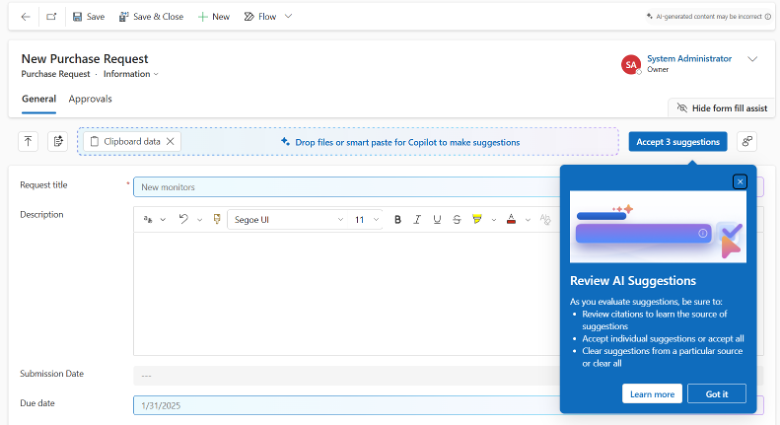
This feature makes it much easier for users to enter data into the system when they need to copy it from other systems, files, or even from paper documents using a photo.
Use the generative AI assistant to simplify form filling in Power Pages:
Overview:
In Power Pages, users will also be able to use AI assistance to fill out forms. This feature is currently in Preview. Users can upload attachments, and the AI will extract the data from them and automatically populate the form.
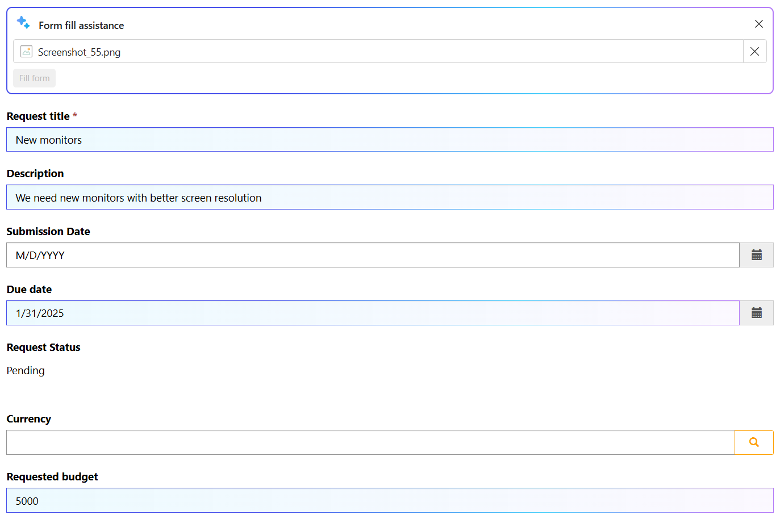
Currently, users cannot automatically fill out a form using copied text. The file upload feature only supports PDF and image formats. Additionally, the assistant is not yet available for multi-step forms or forms used to edit existing records.
Our thoughts:
Once this functionality is officially released and further improved, it has the potential to become a truly valuable tool that will greatly simplify manual data entry for users.
New Dataverse Features:
Use low-code plug-ins in Dataverse:
Overview:
Power Platform developers can now create business logic using Power Fx, which runs on the server side and can be reused across different parts of the system. Previously, developers could only build plug-ins using the traditional approach — writing classic code with the .NET Framework.
Low-code plug-ins are stored in Dataverse, are easily integrated with Power Apps and Power Automate, and can also use external data sources via Power Platform connectors.
Low-code plugins can be triggered either:
- manually by a user,
- or automatically in response to data events such as create, update, or delete operations in the database.
Using low-code plug-ins offers two major advantages when designing a solution’s architecture:
- Improved performance – since the logic executes on the server side, it reduces the load on client devices and speeds up processing.
- Centralized logic management – the business logic is stored in one place on the server, making it much easier to maintain and update, as developers only need to apply changes once rather than in every individual app or flow where the logic is used.
This feature is currently in Preview.
Our thoughts:
Low-code plug-ins are not as powerful as traditional ones, but this innovation significantly simplifies the process of creating server-side business logic. As a result, more Power Platform developers will be able to build such logic without needing additional skills in Visual Studio or writing C# code.
Elastic Tables in Dataverse:
Overview:
Developers can now use elastic Dataverse tables, which are optimized for fast access, high throughput, and instant scalability. The primary purpose of elastic tables is to enable the system to handle large volumes of data in real time without sacrificing performance. As the load increases, these tables automatically leverage more cloud resources, expanding storage capacity and enhancing data processing power. Additionally, it is possible to delete data after a specified period automatically.
However, elastic tables come with a number of limitations. They are not compatible with certain Power Platform features, such as business rules, charts, business process flows, many-to-many (N:N) relationships to standard tables, alternate keys, duplicate detection, calculated and rollup columns, currency columns, and several other functionalities.
Our thoughts:
Elastic tables in Dataverse can be used in a variety of enterprise scenarios. For example, for the following ones:
- Collecting data from social media, websites, or other digital channels to track audience or customer interactions and behavior for further analysis
- Processing orders in E-commerce
- Collecting financial transactions for monitoring purposes
- Tracking stock levels in Retail in real time
- Gathering data from IoT device sensors
- Collecting large volumes of internal system logs
Dataverse Long-Term Data Retention:
Overview:
Power Platform users now have access to a new feature – the ability to store inactive data in long-term storage. Developers can configure a Long-term Data Retention Policy for a specific table and define the criteria that determine when data should be moved to long-term storage.
Users will be able to view this data using the Advanced Find feature in a model-driven application, but they will not be able to edit it. The data will also be available in read-only mode via Power Automate cloud flows and through the Dataverse OData API.
An important aspect to note is that once data is moved to long-term storage, it cannot be restored to active status.
Using Dataverse long-term retention offers several business benefits:
- Cost savings by offloading inactive data from active Dataverse tables (data in long-term storage is approximately 50% smaller than in active storage).
- Access to historical data is maintained to meet legal, audit, and compliance requirements.
- No need to invest in building custom solutions for archiving inactive records.
Our thoughts:
This functionality provides greater flexibility in data management and will be especially valuable for organizations facing increasing data volume demands.
New Power Apps Features:
Work together in real time to create Canvas apps:
Overview:
Multiple developers can now work on the same Canvas app simultaneously. Previously, only one developer at a time could create or edit a Canvas app. With this new capability, users can see who else is currently working on the app and view changes made by others in real time. This experience is similar to how multiple users collaborate on files in SharePoint.
Our thoughts:
Before this feature was available, team members had to take turns working on a Canvas app and coordinate who would edit it and when, while others worked on different tasks. Now, more developers can be involved in delivering large projects, instead of stretching the work over a longer period of time.
However, before deciding to use this feature, keep in mind that you may encounter certain challenges or issues. For example, specialists who have already worked with this functionality warn that it is not yet perfect, and you might face the following limitations:
• The conflict resolution mechanism (when two or more users edit the same control at the same time) may not work reliably and can sometimes result in loss of work.
• Power Apps heavily depends on internet connection quality, so during collaborative editing, you might experience lags, delays, or even unexpected app crashes.
• The audit log lacks detail, which can make it difficult to track who made changes and when.
Act on your data efficiently with new grid features in model-driven apps:
Overview:
Microsoft has significantly expanded and improved the View functionality in model-driven apps. The key user capabilities in the updated grid include:
- Users can reorder columns using drag and drop.
- Fields of the “Choice” type can have colors assigned to their values, which are displayed in the list.
- Users can edit field values directly within the View, without opening the form (see screenshot 1).
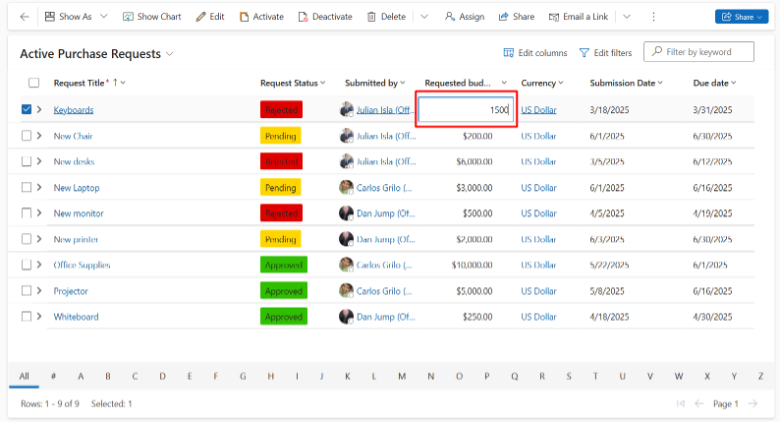
(Screenshot 1)
- Users can view related records for an item in the list directly underneath it, without needing to open the form and navigate to a sub-grid (see screenshot 2):
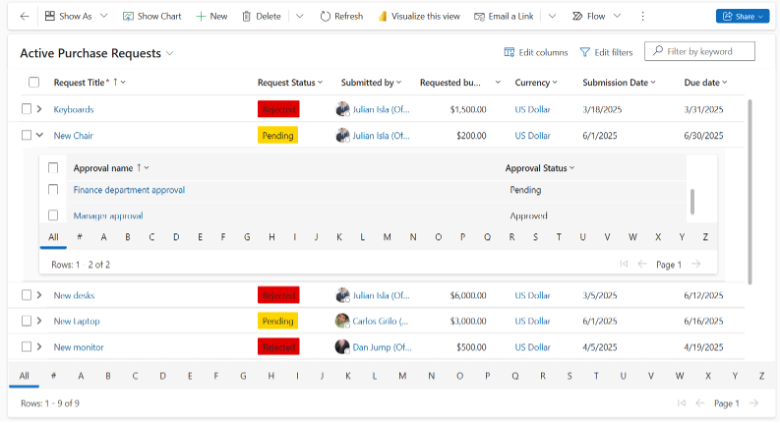
(Screenshot 2)
- Users can group records (see screenshots 3 and 4):
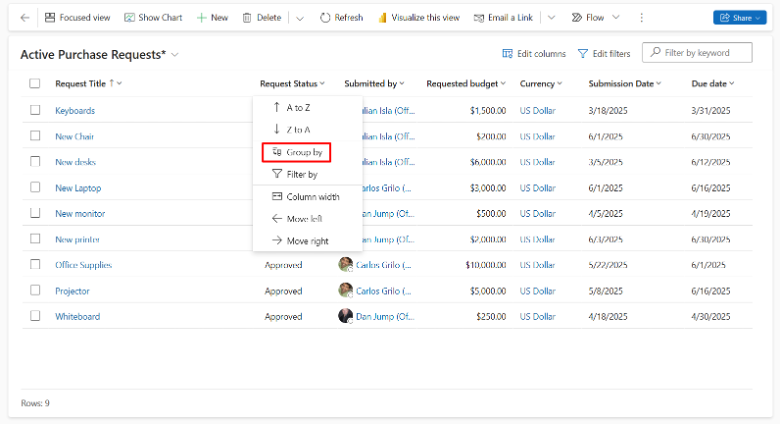
(Screenshot 3)
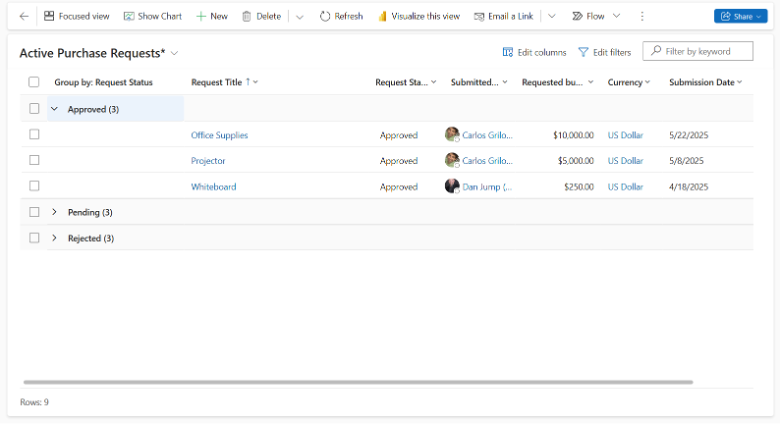
(Screenshot 4)
- Users can aggregate data (see screenshots 5 and 6):
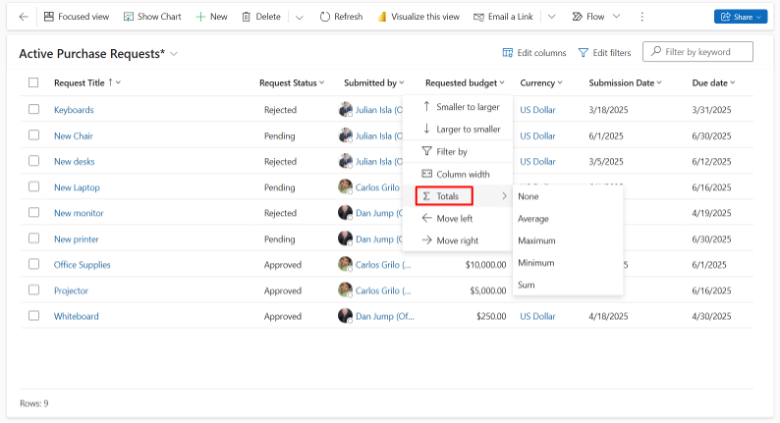
(Screenshot 5)

(Screenshot 6)
Our thoughts:
This enhancement takes the user experience of interacting with data to a new level, while requiring minimal effort from developers to implement, as it is available out of the box and requires only basic configuration.
New Features of Power Pages:
Upload files in Microsoft Azure Blob Storage with Power Pages:
Overview:
The maximum file size for attachments has now been increased to 10 GB (previously it was only 90 MB), thanks to Power Pages’ new capability to connect to Azure Blob Storage. Developers can configure the maximum number of files allowed per record, the maximum file size, and the allowed file types. The user experience has also been improved — a progress bar is now displayed during file uploads.
Our thoughts:
The key advantage of this enhancement is that development teams no longer need to build a custom solution to integrate with Azure Blob Storage, which significantly reduces development time when implementing projects.
Use cloud flows with Power Pages sites:
Overview:
Developers in Power Platform can now trigger Power Automate flows via API. Power Automate has also introduced new connectors that allow data to be retrieved from and sent to Power Pages.
Our thoughts:
While it was previously possible to integrate Power Automate into Power Platform, those approaches often required multiple workarounds and were not always secure. Now, developers can implement desired scenarios and access the full capabilities of Power Automate cloud flows more easily and in a secure way.
New Power Automate Features:
Be more productive with Power Automate and Excel:
Overview:
Using Power Automate cloud flows has taken working with Excel to a new level, significantly speeding up routine business processes and reducing the risk of human error. Now, you can create flows based on templates and manage them directly from within Excel.
Directly in Excel, you can choose a desired template to create a new flow.
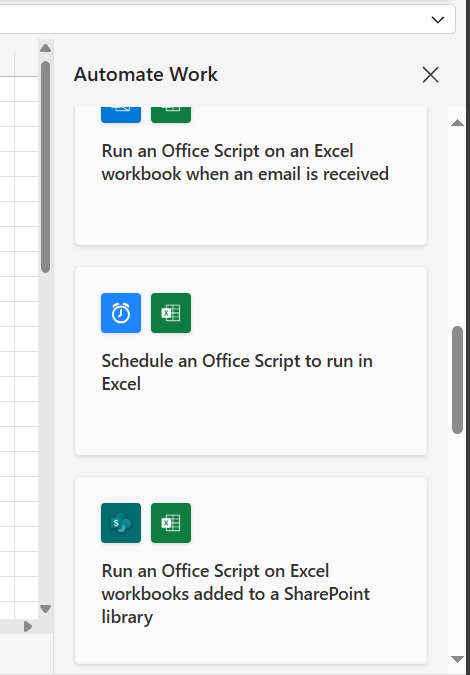
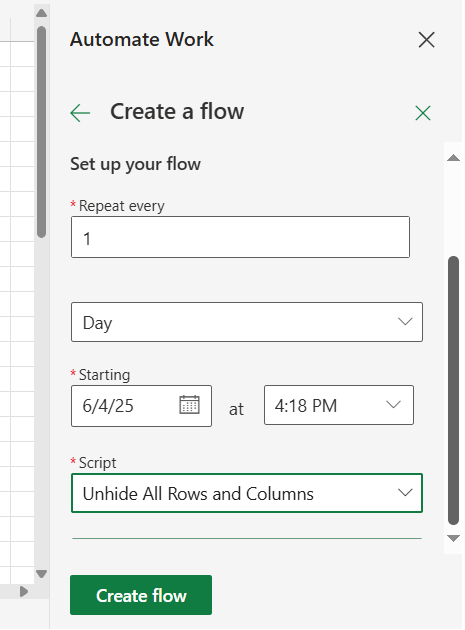
Then, you enter the parameters needed to configure your flow and save it to add it to your workbook.
If needed, you can run, disable, or delete the flow right from Excel, as well as view its details or edit it in Power Automate.
